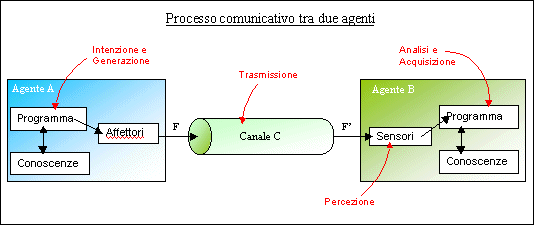





Now that we have introduced the concept of intelligent agent, we can start talking about the speech-understanding problem and analyze the communication process that is established between two (or more) agents(*). In order to simplify the analysis we are used to distinguish in each communication process at least six phases (let me underline that often it is not easy to trace a clean distinction between these phases). The phases are: Intention, Synthesis, Transmission, Perception, Analysis, Acquisition. Between these, the first two take place in the inside of the first agent, the third one in communication channel, the last three in second agent. In fig.2.1 is the communication scheme between two agents.
Intention.
In this phase one of the agents, we say the first one,
that we will call agent A, decides for some reason, to communicate
the concept P to the second agent (agent B). That can happen for
several reasons. We could assume, as example, that the agent A, in
order to get its goal needs some information that B
knows (or better that A suppose B should know). In alternative we
could imagine that it has been B to ask for information to A, and A is
going to answer. Third hypothesis: the two agents could be in
cooperation in order to catch up a common objective and are exchanging
information about their goal-state; or, why not, the two agents could
be in competition and one of them has decided to give to the
other false information. Well, you have understood that we could continue
for a long time to make assumptions on situations in which one of the two
agents decides to do the action of communicating something to
someone. However this phase is not of our interest because it
is independent from the problem of the interpretation of
natural language.
Generation.
The agent A, through its acquaintances on the natural
language formulate the phrase F in order to express the concept P.
Transmission and Perception.
The agent A transmits the phrase F to B. This transmission
can happen for means of sounds (says vocally), in a written form, or
whatever you prefer. The transmission takes place in the channel C, which
can introduce some disturbs (noise) so that
F turns out modified in F'. Also this phase is not of our interest,
and we will suppose to have an ideal channel, that is lacking in disturbs.
This means we'll assume
F = F'. Therefore agent B perceives F' lacking in attenuation and/or
alterations.
Analysis.
Agent B analyzes F' through its acquaintance of the natural
language and he deduces the concept P'. At this point we will say
that the communicative process between A and B have gone to good aim
if P is equal to P'. This mean we want that the concept that
the first agent has expressed has been comprised from the second
one correctly. In this document we will concentrate our attention just on this
phase and the successive one (acquisition).
Acquisition.
Agent B modernizes its knowledge according to the new
concept P'. This doesn't mean that B considers P' true. A
"well structured" intelligent agent would have to be in a position to
decide if to believe or not to believe
to what it has been communicated.

Fig.2.1: Phases of the communication between two agents.
(*) We analyze the communicative process between two agents so as to be able to discuss about its phases on both sides (generation and interpretation/acquisition). The general communication will happen also between more than two agents or an agent and one person.